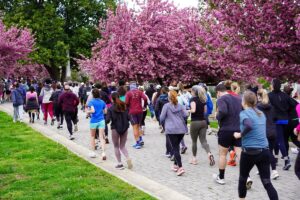By Alisa Harvey
January/February 2010
For the Washington Runing Report
 It can be difficult to achieve and maintain competitive fitness during the cold weather season. The thought of being surrounded by four walls while training is not as appealing as heading outside for a run, but in order to properly prepare for indoor track competition you should include indoor workouts in your routine.
It can be difficult to achieve and maintain competitive fitness during the cold weather season. The thought of being surrounded by four walls while training is not as appealing as heading outside for a run, but in order to properly prepare for indoor track competition you should include indoor workouts in your routine.
While not everyone has daily access to indoor track facilities, many do have access to a treadmill. Treadmill training can assist competitors in maintaining a successful indoor season on the track or be a convenient option for the runner looking to maintain fitness for a spring marathon.
The quality of a workout is based on the speed–not the volume–and speed training in cold weather can be a daunting task. Even while wearing the warmest technical gear, it is unlikely any runner can achieve maximum leg turnover in frosty conditions. Reaching peak training speed may not be possible during the months of January and February, which is why treadmills offer a good alternative.
It is possible to simulate outdoor speed training by utilizing the treadmill’s speed and incline features during a training session. A quality treadmill should be able to reach a maximum speed of 10 to 12 mph with an incline capability of one to 12 percent. Various workouts using fast-paced intervals can be performed on the treadmill that will help in preparing for 400m to 5,000m indoor track events.
First, acclimatizing the body to the warm dry environment of the indoor track arenas is critical for success in the distance races. Sprinters often perform better in warmer temperatures. Preferably, a competitive indoor runner should train regularly in an indoor environment. Occasional workouts and runs in chilly outdoor conditions are a welcomed addition to a runner’s routine, but ideally, interval sessions should be performed indoors.
* The sprinter (55M to 400M) will benefit from the warm temperatures, thus allowing for quick leg turnover.
* The distance runner (800M to 5000M) will benefit from the ability to withstand the comfortable temperatures, thus training longer with more quality.
Prior to the first indoor meet, I recommend spending about two weeks training intermittently in warm, dry, indoor air. A runner that is comfortable training at 45 to 50 degree temperatures may experience dehydration when attempting to race indoors in 60 to 72 degree dry air.
Whatever the situation, treadmill training can provide a varied and successful training regimen for achieving one’s goal. The convenience of treadmill training fits various lifestyles whether it’s the mother of young children who uses a treadmill at home, the business executive who relies on the hotel fitness center treadmill to get ready for his first indoor mile race, or even the part-time student who is employed at the campus gym and squeezes in time for a treadmill workout in preparation for an indoor 5000M.
TREADMILL TRAINING TIPS
Do not step on a moving treadmill belt.
Always stop the treadmill before disembarking.
Do not overestimate your tolerance for the belt speed.
Use lightweight training shoes during workouts.
Speed Workout
(Adjust speed according to your fitness level.)
– Warm up for 5 minutes at 5 mph with a 2% incline.
Stop treadmill. Stretch for 5 to 10 minutes.
Begin running on treadmill at 5 mph with a 2% incline.
Run for 1 minute.
Increase incline to 6%. Increase speed to 7 mph. Run for 30 seconds.
Decrease incline to 2%. Decrease speed to 3.5 mph. Walk for 1 minute.
Increase incline to 6%. Increase speed to 7.5 mph. Run for 30 seconds.
Decrease incline to 2%. Decrease speed to 3.5 mph. Walk for 1 minute.
Continue to increase speed by .5 mph increments until you reach 9 mph.
Begin to decrease speed by .5 mph increments until you reach 7 mph.
Cool down for 5 minutes at 5 mph with a 2% incline.
Finished.
Interval Workout
(Adjust speed and recovery according to your fitness level.)
– Warm up for 10 minutes at 5 mph with a 2% incline.
Stop treadmill. Stretch for 5 to 10 minutes.
Begin running on treadmill at 6 mph with a 2% incline. Run for 90 seconds.
Decrease speed to 5 mph. Jog for 90 seconds. (Maintain a 2% incline throughout workout)
Increase speed to 6.5 mph. Run for 90 seconds.
Decrease speed to 5 mph. Jog for 90 seconds.
Continue to increase speed by .5 mph increments until you reach 7.5 mph.
Begin to decrease speed by .5 mph increments until you reach 6 mph.
Cool down for 10 minutes at 5 mph.
Finished.
Recent Stories
Looking for our race calendar? Click here Submit races here or shop local for running gear
Cherry Blossom 5K 2025 at Congressional Cemetery
Every spring, Congressional Cemetery blooms with new life as we welcome the reawakening of our environmental treasures, including several species of DC’s iconic cherry blossom trees! These beautiful spring hallmarks punctuate every spring in DC with their stunning beauty. While
The Hunter Exam
The Hunter Exam is a unique elimination style fitness event, where finalists earn a coveted “hunter license”. This license not only comes with prestige, but access to future events, perks under The Hunters Association, and private access to the pro






